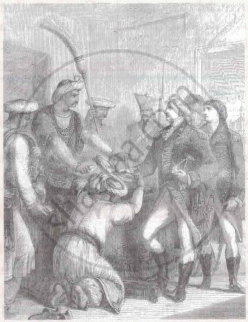Advertisements
Advertisements
Question
Answer the following question briefly:
With reference to the Treaty of Allahabad and its impact, answer the following:
Give an account of the events that followed the death of Mir Jafar, leading to the establishment of the Company as the real ruler of Bengal.
Solution
After Mir Jafar’s death in 1765, his son was made the Nawab of Bengal. He had to sign a treaty with Clive, according to which he had to disband most of his army.
He also had to transfer the ‘Nizamat’ powers (general administration and criminal justice) to a deputy nawab appointed by the British. The deputy nawab could not be dismissed by the nawab. The nawab was given an allowance of 53 lakh rupees which was subsequently reduced. Thus, the English East India Company became the real ruler of Bengal from 1765.
RELATED QUESTIONS
Fill in the blanks:
In 1717, the Mughal emperor granted the United East India Company the right to carry on duty-free trade in __________, ________, and ________.
Fill in the blank:
The French East India Company was established in __________.
Match the Column:
| Column A | Column B |
| 1. Carnatic Wars | (a) Warren Hastings |
| 2. Farman | (b) duty-free trade |
| 3. Roberts Clive | (c) reconquered Calcutta |
| 4. Battle of Plassey | (d) Siraj-ud-Daulah |
| 5. Battle of Buxar | (e) Anglo-French rivalry |
| 6. Governor of Bengal | (f) Mir Qasim |
Choose the correct answer:
The largest and most prosperous European settlement in Bengal was the British settlement at ___________.
Answer the following question in one or two words/sentences:
Why did the farman of 1717 become a bone of contention between the nawabs of Bengal and the British Company?
Answer the following question briefly:
The Battle of Plassey was a major turning point in the history of India. In this context answer the following question:
Give an account of the events leading from the conspiracy to replace Siraj-ud-Daulah to his eventual defeat in the Battle of Plassey.
Answer the following question briefly:
The Battle of Plassey was a major turning point in the history of India. In this context answer the following question:
Why is this battle considered a major turning point in the history of India?
Answer the following question briefly:
With reference to the Treaty of Allahabad and its impact, answer the following:
Explain how the treaty between Robert Clive and the Mughal emperor Shah Alam II legalized English East India’s Company’s control over Bengal.
This picture portrays a momentous event in 1765, involving a British Governor and a Mughal emperor wherein the Mughal emperor is conveying the grant of the Diwani to the governor.

Give a brief account of the battle that preceded this event. When did it take place?
What plot did Robert Clive hatch to remove Siraj-ud- Daulah?
